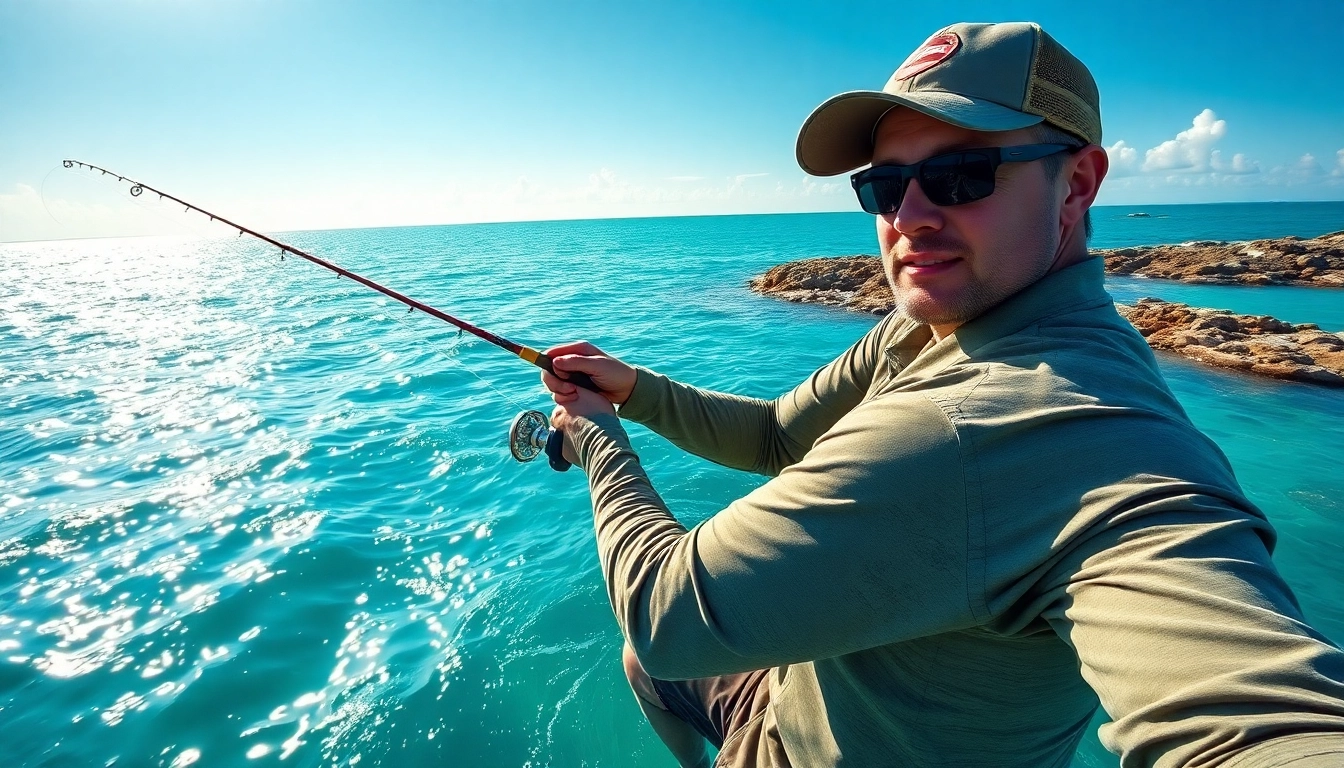Introduction to Saltwater Fly Fishing
What is Saltwater Fly Fishing?
Saltwater fly fishing is a specialized type of fishing that employs fly rods and reels to catch fish in saltwater environments. This exhilarating activity often attracts anglers seeking the thrill of targeting larger and more challenging species than those found in freshwater settings. The art of fly fishing dates back centuries, but as the techniques evolve, so do the tactics tailored specifically for saltwater fishing. In essence, the practice combines the finesse of casting flies with the ruggedness of ocean fishing, requiring both skill and knowledge of marine ecosystems. If you’re looking to embark on this exciting journey, mastering the nuances of saltwater fly fishing can elevate your angling skills tremendously. For your gear needs, reputable shops specializing in saltwater fly fishing can provide valuable resources.
Key Gear and Equipment Needed
Equipping yourself with the right gear is essential for successful saltwater fly fishing. The following are some of the fundamental pieces of equipment:
- Fly Rods: Typically, rods suited for saltwater environments are longer, ranging from 8 to 12 feet and rated for the power to handle large fish.
- Fly Reels: A high-quality reel with a strong drag system is vital due to the size and strength of saltwater species.
- Lines: Specialty saltwater fly lines are heavier and designed to withstand the corrosive elements of marine environments.
- Flies: A selection that mimics baitfish, crustaceans, and other local prey is crucial. Patterns such as Clousers, Deceivers, and Poppers work well.
- Leaders and Tippets: These should be strong and abrasion-resistant, typically using a shock leader to handle the fight.
- Clothing and Accessories: Wearing UV-protective clothing, a hat, polarized sunglasses, and a good pair of wading boots can enhance comfort and safety while fishing.
Understanding the Ecosystems
A comprehensive understanding of saltwater ecosystems is critical for any aspiring saltwater fly angler. Key elements to consider include:
- Habitat Types: Key habitats include flats, estuaries, reefs, and offshore waters. Each habitat supports different species and requires distinct fishing approaches.
- Fish Species: Common targets such as tarpon, bonefish, and permit inhabit these ecosystems. Knowing their behaviors and habitats increases chances of success.
- Tides and Currents: These natural forces significantly affect fish activity and feeding patterns. Understanding how tides work will help you time your fishing trips effectively.
- Weather Conditions: Wind and precipitation can impact visibility and fish behavior. Familiarity with local weather patterns aids in planning trips for optimal results.
Choosing the Right Locations
Top Saltwater Fly Fishing Destinations
Saltwater fly fishing can take you to exquisite locations around the world. Here are a few notable spots:
- Bahamas: Known for its pristine flats and abundant species like bonefish and permit, the Bahamas is a paradise for saltwater fly fisher.
- Florida Keys: This tropical region provides diverse fishing experiences, from shallow flats to deep-sea excursions.
- Belize: Renowned for its barrier reef and rich marine life, Belize offers excellent fishing opportunities among its beautiful surroundings.
- Mexico’s Yucatan Peninsula: Home to some of the best flats fishing in the world, particularly for bonefish, tarpon, and permit.
- Australia’s Great Barrier Reef: This marvel of nature presents incredible opportunities to target species such as giant trevally and barramundi.
What to Consider When Selecting a Spot
When choosing a location for saltwater fly fishing, consider these crucial factors:
- Access: Ensure you can reach the fishing spots easily, either from shore or by boat.
- Time of Year: Different species are more plentiful at specific times, influenced by breeding cycles and migratory patterns.
- Local Regulations: Always check local fishing laws, including licenses, catch limits, and protected areas to avoid fines or damaging the environment.
- Guided Tours: Beginner anglers may benefit from hiring local guides, who possess invaluable knowledge about the waters and fish behaviors specific to the area.
Preparing for Your Saltwater Fly Fishing Trip
Successful preparation can significantly influence the outcome of your fishing trip. Key steps include:
- Research: Study local fishing reports and conditions to gain insights about fish activity and trends.
- Packing Essentials: Besides your fishing gear, pack necessary personal items like sunscreen, snacks, and first-aid kits.
- Practice Casting: Before you head out, practice your casting technique to ensure confidence and improve accuracy.
- Travel Insurance: Consider purchasing travel insurance that covers fishing trips, including potential cancellations or equipment damage.
Essential Techniques for Success
Basic Casting Techniques Explained
Effective casting is paramount in saltwater fly fishing. The following basic techniques will aid your casting proficiency:
- Forward Cast: The key is to make a smooth, controlled movement that propels the line forward while keeping the tip high to avoid splashing.
- Backcast: This is the first part of your casting motion. Keeping a straight line and allowing the fly to load the rod is crucial for optimal distance.
- Double Haul: This technique involves pulling the line during both the backcast and forward cast, adding speed and distance to your cast.
- Roll Cast: Ideal for situations where backcasting is limited, this technique allows you to cast line without needing a full backcast.
Advanced Strategies for Catching Different Species
Once you master the basics, you can implement advanced techniques tailored to specific species:
- Bonefish: Use long leaders and lightly weighted flies for these cautious fish. Casting ahead of the fish and allowing the fly to sink naturally often yields the best results.
- Tarpon: Use fast strips and a strong hook set when you feel a bite. Tarpon are known for their aggressive behavior and aerial acrobatics, making quick reflexes essential.
- Permit: These fish are notoriously tricky. Use crab patterns and practice stealth in your approach to avoid spooking them.
Utilizing Tides and Weather for Better Results
A successful saltwater fly fishing experience hinges on your ability to read tides and weather conditions:
- Understanding Tides: Fish tend to be more active during rising and falling tides. Focusing your efforts during these times can lead to successful catches.
- Wind Direction: Wind can aid or hinder your casting. Casting with the wind can improve distance while casting against may require more effort.
- Temperature Changes: Water temperature greatly influences fish behavior. Warmer waters may stimulate feeding activity, while cooler conditions may lead them to conserve energy.
Common Challenges in Saltwater Fly Fishing
Dealing with Difficult Conditions
Every angler encounters challenging conditions at some point. Here’s how to navigate them:
- Wind: Windy conditions can complicate casting. Adjust your casting technique by keeping your line low and using short, quick casts.
- Cloudy Days: These can be tricky since visibility decreases for both you and the fish. Use bright or noisy flies to attract attention regardless of low visibility.
- Strong Currents: When faced with powerful currents, concentrate on the eddies where fish may be holding and use heavier flies to maintain depth.
Overcoming Equipment Failures
Equipment failure can be frustrating. Be prepared by:
- Regular Maintenance: Periodically check your gear, ensuring all components function properly, especially the reel drag.
- Bringing Spares: Having a spare rod and leader material can save a day’s fishing when things go wrong.
- Knowing How to Fix Common Issues: Familiarize yourself with basic repairs like line tying and reel adjustments, so you are ready to act quickly.
Managing Fish Behavior and Feeding Patterns
Understanding fish behavior and their feeding patterns is crucial:
- Time of Day: Fish are often more active during dawn and dusk, so schedule your outings accordingly.
- Seasonal Changes: Fish species may migrate or change feeding habits based on seasonal variations, requiring adaptation of bait and flies.
- Sight Fishing: This is particularly effective in clear waters. Being able to see fish will help you understand their behavior and plan your casts more effectively.
Tips for Capturing Your Saltwater Fly Fishing Experience
Documenting Your Adventures Effectively
Creating lasting memories of your fishing excursions is vital:
- Photography: Capture high-quality photos of your catches in different angles, and include background elements to display the beauty of the environment.
- Journaling: Maintain a fishing journal to document catches, conditions, and techniques used. This can help inform future trips.
- Video Documentation: Recording your experiences can also help you analyze techniques and progress over time.
Sharing Your Stories and Tips with the Community
Engaging with the fishing community encourages sharing tips and experiences:
- Online Forums: Join communities, forums, or social media groups focused on saltwater fly fishing to share stories and learn from others.
- Blogging: Consider starting a personal blog where you can document and share your insights and techniques.
- Volunteer for Conservation: Participate in local conservation efforts, which provides networking opportunities while supporting the environments you enjoy.
Continuously Improving Your Skills
Fly fishing is an ever-evolving sport where continuous improvement is key:
- Attend Workshops: Participate in workshops or seminars focused on saltwater fly fishing to improve techniques and strategies.
- Hire a Guide: Learning from experienced guides can provide invaluable skills and local fishing insights.
- Practice Regularly: Frequent practice in casting and techniques will lead to expertise, so make time for consistent practice sessions.





Leave a Reply